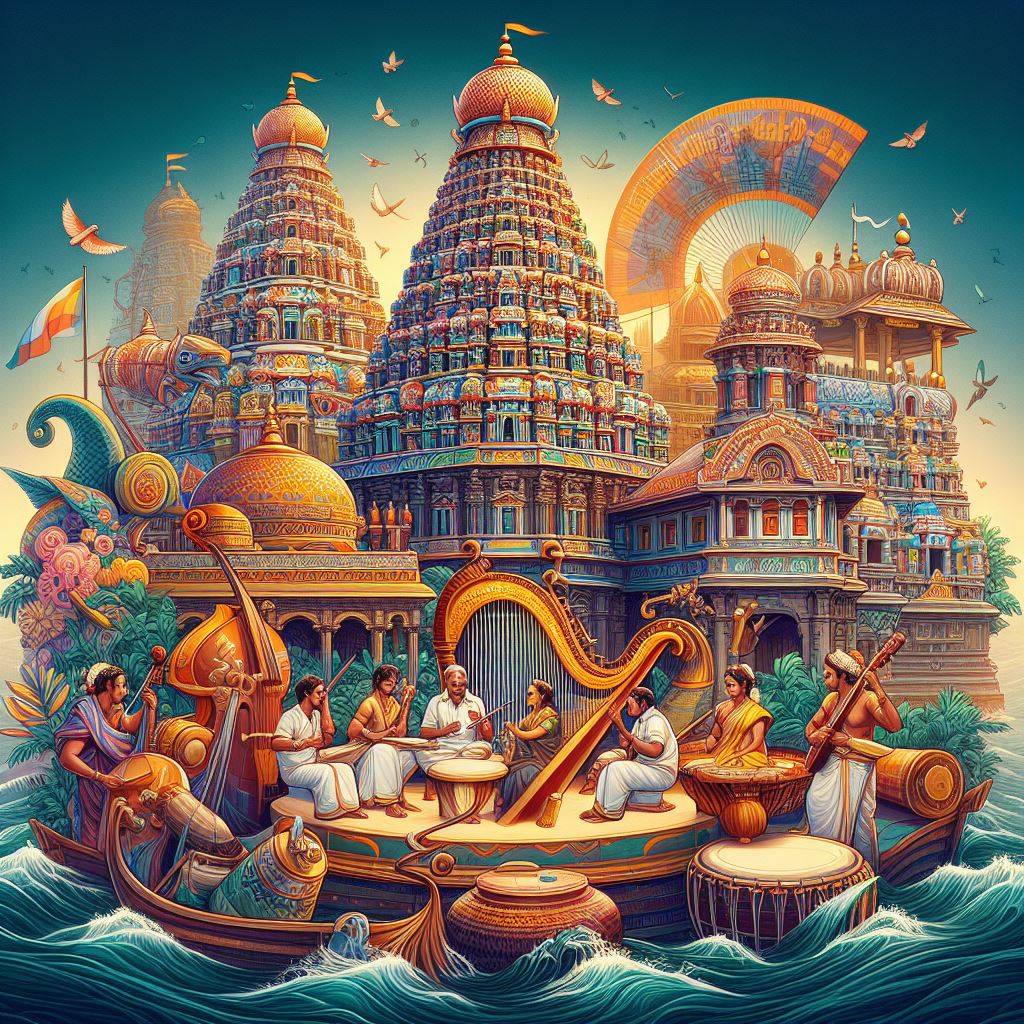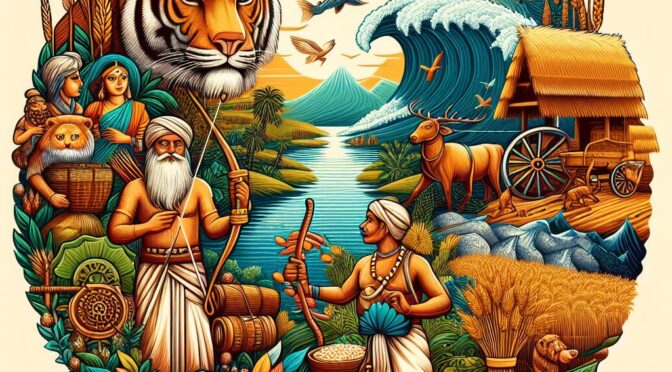Tamil is one of the oldest living languages still in use today. Tamil is the mother tongue of the Tamil people. Tamil literature is rich and includes ancient Tamil literature, poetry, philosophical works and modern literary works. The Tamil literary tradition has famous poets like Tiruvalluvar and Ilango Adi.
Tolkappiyam is the oldest surviving work of Tamil literature and linguistics. Tolkappiyam is a work on the grammar of the Tamil language. .Written in the form of poems (or short hymns) by Tolkappiyam around 200 BC, it is said to be the oldest grammar of any language in the world. Tamil literature consists of poems and texts that provide valuable insights into the social, cultural and economic life of ancient Tamils.

The Yazh being in old Tamil stories tells us a lot about how important music was to Tamil people. It probably wasn’t just for fun; it likely had a role in religious stuff and parties too. Seeing the Yazh in old pictures and trying to bring it back to life today helps keep Tamil history alive.
Tamil music is an important part of Tamil culture, Tamil music, a classical music form, occupies an important place. Many new genres of music were also influenced by Tamil music. Carnatic music has undoubtedly been influenced by the Tamil traditions of music over the centuries. Some scholars trace the roots of many Carnatic ragas to musical Tamil hymns (Abraham Pandithar. Karunamirthasagaram, 1917- https://archive.org/details/tamil-christian-ebook-karunamirtha-sagaram-abraham-pandidar).The book describes how specific musical Tamil melodies evolved into Carnatic ragas. It will also analyze the similarities and differences between the melodic structures of Tamil and Carnatic music. It examines how Carnatic musical performances incorporate elements of musical Tamil traditions.
Tamil heritage is full of cultural traditions and festivals. Nadukal worship and Pongal are some of the major festival celebrations of Tamil people. Nadukal, the earliest form of traditional Tamil worship, is a type of stone found in the southern Indian state of Tamil Nadu. These stones are usually without figures, and are erected to commemorate the death of these individuals. And they are considered to have played an important role in the development of Tamil beliefs.
Tamil Nadu has a long history of martial arts including Silambam and Varmak Kalai. Varmak Kalai is a Tamil martial art and healing system that uses stimulation of specific points on the body called Varma to treat pain and other health conditions. Varma points are believed to be areas where vital energy or vital energy is concentrated. Varma art therapy is drug-free, non-invasive and easy to learn. Silambam is a martial art based on a long stick (stick) from the Tamil Nadu region of India, and is traditionally practiced by the Tamil community.
The coastal areas of Tamil Nadu were important centers of trade and maritime activities in ancient times. The region had extensive contacts with other civilizations through maritime trade routes.
Siddha medicine, an ancient traditional medical system, is an integral part of the Tamil tradition. Siddha doctors use herbal remedies and holistic approaches to maintain health and treat diseases.
Tamil heritage has left an extraordinary legacy of art and architecture. Temples such as the Thanjavur Periya Kovil in Tamil Nadu showcase beautiful Tamil architecture known for its intricate carvings and towering gateways.
The Tamil art of dancers dedicated to temples was formerly known as Satir Attam or Tasi Attam. It is the first of India’s traditional dances to be reimagined by dramatists and widely exhibited both at home and abroad. Bharatanatyam is a new classical dance form derived from Satir dance.Bharatanatyam originated from the temple dance traditions of Tamil Nadu, including Bharatanatyamthortam, Satir Atham, and was revived and reformulated by Indian dance gurus in the early 20th century. Bharatanatyam is considered to be a derivative or evolved form of satir dance.
Bharatanatyam borrowed elements from satir dance, including basic postures, rhythmic patterns, and expressive movements.However, Bharatanatyam incorporated elements from other South Indian dance traditions to become a more formalized art form.(https://worlddanceheritage.org/bharathanatyam/)
Underground excavations are rewriting Indian history by providing evidence of sophisticated urban settlement in Tamil Nadu during the Adi (Sanga) period. The findings provide valuable insights into the social structure, economic activities and cultural practices of this ancient civilization. Evidence suggests a well-developed urban settlement dating back to the prehistoric period (6th century BC to 1st century AD). This challenges the traditional view of this period (Keeladi 2019, Department of Archaeology, Government of Tamil Nadu https://archive.org/details/KeeladiEnglish).
Tamil heritage plays an important role in shaping the culture and identity of Tamil speaking people in India and around the world. It has left an indelible mark on various aspects of human civilization and is constantly celebrated and preserved by Tamil communities around the world.

